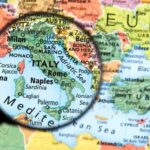Italy, one of the most popular tourist destinations in the world, has recently been making headlines for its changing travel restrictions. As the country grapples with the ongoing COVID-19 pandemic, it has had to adapt its policies in order to ensure the safety of both its residents and visitors. In this article, we will delve into the impact of Italy’s changing travel restrictions, examining their background, current situation, and future implications.
In recent years, Italy has experienced a significant boom in tourism, contributing greatly to its economy. However, since the outbreak of the pandemic, strict travel restrictions were put in place to limit the spread of COVID-19.
These measures had a profound impact on Italy’s tourism industry, causing a sharp decline in visitor numbers and revenue loss for businesses dependent on travelers. The need for change became apparent as the country sought to strike a delicate balance between controlling the virus and reviving its crucial tourism sector.
Fortunately, Italy has made significant strides in controlling the spread of COVID-19. Through stringent measures such as lockdowns and widespread testing and vaccination campaigns, the country has managed to bring down infection rates and ease some of its travel restrictions. However, this progress comes with challenges and complexities, particularly when it comes to striking a balance between economic recovery and public health safety.
As we explore Italy’s changing travel restrictions further in this article, we will analyze how the government responded to these challenges and what revised guidelines have been put in place for travelers. Additionally, real-life stories from individuals facing Italy’s changing restrictions will provide insights into their experiences. We will also examine the stringent safety measures that have been implemented to protect travelers as they navigate through these changes.
With practical advice for travelers on how to navigate Italy’s changing restrictions seamlessly and an exploration into what lies ahead for Italian tourism post-pandemic, this article aims to shed light on Italy’s decision-making process surrounding travel regulations while offering valuable insights for those planning a visit to this beautiful country.
Background
Italy, one of the world’s most popular tourist destinations, was hit hard by the COVID-19 pandemic. As a result, the country implemented strict travel restrictions to control the spread of the virus. In this section, we will explore Italy’s original travel restrictions and understand how they impacted the tourism industry.
When the pandemic first hit Italy in early 2020, the country was one of the hardest hit in Europe. The government responded by implementing a nationwide lockdown and travel restrictions to curb the spread of the virus. These restrictions included closing borders, canceling flights, and imposing quarantine requirements for anyone entering or leaving the country.
These measures had a severe impact on Italy’s tourism industry, which is a crucial sector of its economy. The country is famous for its historical landmarks, art cities, beautiful landscapes, and culinary delights that attract millions of tourists every year. However, with travel restrictions in place and people reluctant to travel due to safety concerns, tourist arrivals dropped significantly.
The decline in tourism had far-reaching consequences for Italy’s economy. Thousands of businesses dependent on tourism revenue faced financial struggles and many workers in this industry lost their jobs. Small businesses like hotels, restaurants, and local artisan shops suffered greatly as international tourists were unable to visit and spend money.
Additionally, cultural heritage sites such as museums were forced to close their doors to visitors for an extended period of time. This not only led to a decline in revenue but also deprived people from experiencing Italy’s rich heritage.
In summary, Italy’s original travel restrictions aimed at protecting public health during the pandemic had a severe impact on its tourism industry. The decline in tourist arrivals resulted in economic challenges for businesses relying on tourism revenue and limited access to cultural sites for visitors. However, as we delve into the current situation and upcoming changes in travel restrictions in subsequent sections, it becomes evident that Italy is making efforts to revive its tourism industry while ensuring public safety.
Current Situation
Italy has made significant progress in controlling the spread of COVID-19, leading to a change in their travel restrictions. The current situation in Italy reflects the efforts made by the country to mitigate the impact of the pandemic and prioritize public health.
Decrease in COVID-19 Cases
Italy has experienced a significant decrease in the number of COVID-19 cases recorded daily, indicating a positive trend in their battle against the virus. The stringent measures implemented since the outbreak have contributed to flattening the curve and reducing transmission rates. The efforts made by Italian citizens to adhere to social distancing guidelines and wear masks have played a crucial role in containing the virus.
Vaccination Campaign
The successful rollout of Italy’s vaccination campaign has also contributed to their progress in controlling the spread of COVID-19. The government has prioritized vaccinating vulnerable populations and healthcare workers, ensuring that those at highest risk are protected against severe illness. As more individuals receive their vaccinations, there is an increasing sense of optimism regarding Italy’s ability to manage the virus effectively.
Easing of Restrictions
As a result of these positive developments, Italy has decided to ease some of its travel restrictions. This decision is rooted in both their success in controlling the spread of COVID-19 and recognizing the importance of tourism for their economy. By relaxing travel restrictions, Italy hopes to revive its tourism industry while maintaining stringent safety measures.
Overall, Italy’s current situation showcases promising progress in managing COVID-19 and provides an opportunity for change regarding travel restrictions. It is crucial for travelers to stay updated on any new guidelines or requirements as they plan their trips to Italy during this evolving situation.
The Need for Change
The tourism industry plays a vital role in Italy’s economy, contributing significantly to its GDP and providing employment opportunities for thousands of people. However, the COVID-19 pandemic has severely impacted the tourism sector, leading to a dire need for change in travel restrictions.
Italy’s original travel restrictions implemented during the height of the pandemic were necessary to curb the spread of the virus and protect public health. However, these measures had detrimental effects on the tourism industry. Travel bans, mandatory quarantine periods, and stringent entry requirements resulted in a significant decrease in international tourist arrivals. According to data from Statista, Italy experienced an 85% decline in international tourist arrivals in 2020 compared to the previous year.
The economic strain on the tourism industry has been profound, with many businesses facing closures and job losses. Hotels, restaurants, tour operators, and other service providers heavily reliant on international tourists suffered from reduced demand and financial distress.
The impact was particularly severe for popular tourist destinations such as Rome, Florence, Venice, and the Amalfi Coast. According to research by Confindustria (the Confederation of Italian Industry), Italy’s tourism sector lost approximately €171 billion ($204 billion) in revenue due to the pandemic.
To address this economic crisis and revive the struggling tourism industry, Italy recognizes the need for change in its travel restrictions. The government understands that balancing public health concerns with supporting economic recovery is crucial. By implementing revised travel guidelines that prioritize safety while facilitating tourist arrivals, Italy aims to stimulate domestic and international travel and revive its hospitality sector.
| Key Statistics | Data |
|---|---|
| Decline in international tourist arrivals in 2020 compared to the previous year | 85% |
| Total revenue lost by Italy’s tourism sector due to the pandemic | €171 billion ($204 billion) |
These statistics highlight the devastating impact of the COVID-19 pandemic on Italy’s tourism industry and emphasize the urgency of implementing changes in travel restrictions. By doing so, Italy hopes to rebuild its economy, protect livelihoods, and restore its standing as one of the world’s premier tourist destinations.
Italy’s Response
As the COVID-19 pandemic continues to evolve, countries around the world are constantly reassessing their travel restrictions and guidelines. Italy, one of the most popular tourist destinations in the world, has been no exception. In this section, we will analyze Italy’s response to the changing landscape of travel restrictions and explore the government’s decision to alter them.
Italy was hit hard by the initial wave of COVID-19 cases and implemented strict travel restrictions in an effort to control the spread of the virus. These measures included a ban on non-essential travel, closure of borders, and mandatory quarantine for incoming travelers. However, with significant progress in controlling the virus and decreasing case numbers, the Italian government has started to loosen these restrictions.
The decision to change travel restrictions in Italy was driven by a combination of factors. Firstly, there is a pressing need to revive the country’s struggling tourism industry.
Tourism contributes significantly to Italy’s economy, and the absence of international visitors over an extended period has had a devastating impact on businesses and livelihoods reliant on tourism revenue. Secondly, as vaccination rates increase globally and more people become immune or have been vaccinated against COVID-19, there is growing confidence that international travel can resume safely with proper precautions in place.
To address these concerns while prioritizing public health, Italy has now adopted a tiered system for travel restrictions based on risk levels associated with different countries or regions. The government assesses a range of factors such as vaccination rates, infection rates, and variants of concern before classifying countries into different risk categories. This enables them to tailor their travel requirements accordingly.
Italy now allows travelers from certain low-risk countries or regions unrestricted entry without testing or quarantine requirements. However, passengers from high-risk areas may still face stricter measures such as pre-departure testing and mandatory quarantine upon arrival.
To monitor this tiered approach effectively, Italy has implemented robust surveillance and monitoring systems. These include online registration forms for travelers, random testing at airports, and rigorous contact tracing efforts. By closely monitoring the situation and adjusting restrictions as necessary, Italy aims to strike a balance between reinvigorating its tourism industry and safeguarding public health.
Updated Guidelines
Understanding the New Guidelines
Italy has recently made significant changes to its travel restrictions and requirements in response to the evolving COVID-19 situation. These updated guidelines aim to strike a balance between preventing the spread of the virus while allowing for safe travel and supporting the struggling tourism industry. Understanding these revised restrictions and requirements is essential for anyone planning to visit Italy.
One of the key changes involves the relaxation of entry restrictions for travelers from certain countries with low infection rates. Previously, travelers from these countries were subject to a mandatory quarantine upon arrival in Italy.
However, under the updated guidelines, fully vaccinated travelers or those who have tested negative within a specified timeframe prior to their trip may be exempt from quarantine requirements. It is important to note that this exemption applies only to travelers from designated countries on Italy’s approved list.
Additionally, travelers will still need to fill out a self-declaration form stating their purpose of travel and agreeing to abide by all health protocols. This includes wearing masks in all public spaces, practicing social distancing, and following any local regulations or guidelines. It is crucial for travelers to stay informed about any specific requirements based on their destination within Italy, as rules may vary between regions.
Testing and Vaccination Requirements
As part of the revised guidelines, Italy has implemented testing and vaccination requirements for entry into the country. Travelers will be required to provide proof of a negative COVID-19 test result taken within a specified timeframe before their departure. The type of test accepted may vary, but generally includes PCR tests or antigen tests administered by authorized laboratories or medical professionals.
Alternatively, fully vaccinated individuals may be exempt from testing requirements if they can provide valid proof of vaccination issued by an authorized health authority. It is important for travelers to ensure that their vaccines are recognized by Italian authorities and meet all necessary criteria.
Impact on Travelers
These updated guidelines have both positive and challenging implications for travelers. On one hand, the relaxation of entry restrictions for vaccinated individuals or those who test negative allows for greater freedom and accessibility. It also provides a much-needed boost to the tourism industry, which has been severely impacted by the pandemic.
However, it is essential that travelers stay vigilant and adaptable as guidelines may change frequently based on the evolving COVID-19 situation. Travelers should closely monitor travel advisories issued by their own country’s government as well as from Italian authorities. Flexibility in travel plans, including potential changes to itinerary or accommodations, is recommended to navigate any unexpected restrictions or requirements.
By understanding and adhering to these revised guidelines, travelers can play an important role in ensuring the safety of themselves and others while still enjoying all that Italy has to offer.
Traveler Experiences
Italy’s changing travel restrictions have had a significant impact on individuals around the world who had plans to visit or were already in Italy. Real-life stories of these individuals provide valuable insight into the challenges and experiences faced due to these changing restrictions.
- Travelers stranded in Italy: Many individuals found themselves stranded in Italy when the country initially implemented travel restrictions. These stories highlight the difficulties they faced in finding accommodation, accessing essential services, and obtaining information about repatriation flights. Some travelers were unable to return home for an extended period, causing emotional distress and financial strain.
- Canceled trips and disappointment: Numerous people had their long-awaited trips to Italy abruptly canceled due to changing travel restrictions. These stories illustrate the disappointment and frustration experienced by travelers who had meticulously planned their itineraries and invested time and money into their dream vacations. Many faced challenges in obtaining refunds or rescheduling their trips.
- Adaptability in uncertain times: Despite the adversities caused by changing travel restrictions, some visitors shared inspiring stories of adaptability and resilience. They described how they made the most out of their altered travel plans by exploring lesser-known destinations within Italy, connecting with locals through online platforms, or participating in virtual tours to experience Italian culture from afar.
These traveler experiences demonstrate not only the personal impact but also shed light on the broader implications of Italy’s changing travel restrictions on tourism-related industries and local businesses that rely heavily on international visitors. Their stories serve as a reminder of the importance of flexibility and understanding during these unprecedented times.
- Travelers stranded abroad
- Canceled dream vacations
- Finding opportunity amidst uncertainty
Safety Measures
Italy has implemented stringent safety measures for travelers in order to mitigate the risk of COVID-19 transmission. These protocols are crucial in maintaining the health and well-being of both residents and visitors to Italy. By enforcing these measures, Italy aims to strike a balance between reopening its tourism industry and ensuring public safety.
Firstly, all travelers entering Italy must provide proof of a negative COVID-19 test result taken within 48 hours before arrival. This requirement applies to individuals coming from high-risk countries as well as those who have spent time in transit through such countries. The test must be a molecular or antigenic one and travelers are required to present the test result before boarding their flight or when entering the country by land or sea.
In addition, travelers must complete an online self-declaration form that includes information such as their contact details, intended destination in Italy, and confirmation that they have not experienced COVID-19 symptoms in the 14 days prior to their arrival.
Upon arriving in Italy, travelers may be subject to temperature checks and further testing at airports or other designated entry points. Travelers who test positive for COVID-19 will be required to quarantine for 10 days at their own expense. It is recommended that travelers have travel insurance that covers medical expenses abroad, including potential COVID-19 related costs.
These safety measures aim to prevent imported cases of COVID-19 and minimize the risk of community transmission within Italy. By adhering to these protocols, both travelers and locals can feel confident that necessary precautions are being taken to protect public health.
| Safety Measures | Description |
|---|---|
| Negative COVID-19 Test | All travelers must provide proof of a negative COVID-19 test taken within 48 hours before arrival. |
| Online Self-Declaration | Travelers must complete an online self-declaration form with their contact details and confirmation of no COVID-19 symptoms. |
| Temperature Checks | Upon arrival, travelers may undergo temperature checks to identify potential cases of COVID-19. |
| Mandatory Quarantine | Travelers testing positive for COVID-19 will be required to quarantine for 10 days at their own expense. |
| Travel Insurance | It is recommended that travelers have travel insurance covering medical expenses abroad, including COVID-19 related costs. |
Tips for Travelers
With Italy’s changing travel restrictions, it is important for travelers to be prepared and informed before embarking on their journey. Navigating these fluctuations in guidelines can seem daunting, but with some practical advice, travelers can ensure a smoother experience during their visit to Italy.
First and foremost, it is crucial to stay updated on the latest travel restrictions and requirements set by the Italian government. These may change frequently depending on the COVID-19 situation in both Italy and the traveler’s home country. Checking official government websites and reputable travel sources regularly will provide accurate and reliable information.
Another important tip is to plan and book ahead. Due to capacity limitations or enhanced safety measures, attractions, restaurants, and accommodations may require advanced reservations. By planning ahead and securing bookings beforehand, travelers can avoid disappointment or any last-minute inconveniences.
Travelers should also consider obtaining travel insurance that covers COVID-19-related issues. This will provide financial protection in case of unexpected cancellations or medical emergencies while abroad. It is advisable to carefully read through the terms and conditions of the insurance policy to understand what is covered specifically in relation to COVID-19.
It is crucial to adhere strictly to all health protocols implemented by the Italian authorities. This includes wearing face masks in public areas, practicing social distancing, and regular hand sanitization. Familiarizing oneself with these safety measures before arriving in Italy will make it easier to adapt quickly.
Lastly, maintaining flexibility in travel plans can help mitigate any unforeseen circumstances arising from changing restrictions. It is wise for travelers to have backup options or alternative itineraries if certain destinations become inaccessible due to sudden changes in regulations.
By following these practical tips for navigating Italy’s changing travel restrictions, travelers can have a more seamless experience while exploring this beautiful country. However, it remains essential for individuals to stay vigilant and responsible throughout their journey, adapting as necessary to the evolving situation surrounding the pandemic.
The Future Outlook
As Italy continues to make changes to its travel restrictions in response to the COVID-19 pandemic, it is essential to examine the potential implications of these alterations. The future outlook for Italy’s changing travel restrictions can significantly impact the country’s tourism industry and economy as a whole.
- Decrease in Tourism Revenue: Italy heavily relies on tourism as a major contributor to its economy. With the implementation of stricter travel restrictions, there is likely to be a decrease in tourist arrivals, resulting in a significant decline in tourism revenue. Hotels, restaurants, tour operators, and other businesses that depend on tourism will bear the brunt of these effects. This could lead to job losses and financial instability for many individuals and companies across the country.
- Recovery of the Tourism Industry: While changing travel restrictions may initially have negative consequences, they could also signify progress in controlling the spread of COVID-As more people feel confident traveling to Italy due to improved safety measures, there is hope for a gradual recovery of the tourism industry. However, this recovery may take time and require concerted efforts from both the government and businesses to regain travelers’ trust.
- Impact on Local Communities: The changing travel restrictions will not only affect businesses but also have a broader impact on local communities that heavily rely on tourism as their primary source of income. Hotels closing down, restaurants operating at reduced capacity, and limited visitor numbers at popular attractions may result in an overall slowdown in local economies.
It is crucial for policymakers and stakeholders involved in tourism to come up with strategies and initiatives that support these communities during this challenging period.
Conclusion
In conclusion, the decision to alter travel restrictions in Italy comes with both potential benefits and challenges. On the one hand, loosening restrictions will undoubtedly provide a much-needed boost to the struggling tourism industry, which has been severely impacted by the pandemic. The influx of tourists will bring economic relief for businesses and individuals who heavily rely on tourism for their livelihoods.
Furthermore, with Italy’s progress in controlling the spread of COVID-19, it is natural for the government to consider easing restrictions and allowing travelers to visit once again. This decision reflects the country’s growing confidence in its ability to manage the virus and protect its citizens while resuming international travel.
However, there are also potential challenges that must be addressed. The safety of both locals and visitors must remain a top priority as Italy opens its borders. Stringent protocols implemented for travelers will play a crucial role in mitigating the risk of infection and ensuring a safe travel experience.
It is also important for travelers to stay informed and adapt to changing guidelines. As seen throughout this article, Italy’s travel restrictions have evolved over time based on the current situation. Therefore, it is essential for travelers to remain flexible and prepared for any changes that may occur during their trip.
Ultimately, altering travel restrictions carries inherent risks but offers potential rewards as well. Italy’s decision reflects a careful balance between reviving its tourism industry and safeguarding public health. As long as safety measures are effectively implemented and followed by both residents and travelers alike, we can hope that Italy’s reopening will bring positive outcomes for all involved parties while still prioritizing health and safety concerns.

I’m a passionate traveler, writer, and Italophile. My fascination with Italy’s history, art, and culture has led me on countless adventures across the Italian landscape. Through “I Live Italy,” I share my love for this extraordinary country and aims to inspire others to explore its boundless beauty.





